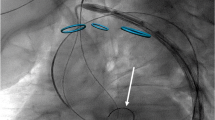Abstract
In this technical report, we describe a challenging case concerning the retrieval of a distal embolic protection device (DEPD) post-carotid artery stenting. We propose a novel rescue retrieval technique for DEPD, employing a fabricated monorail-type HN5 diagnostic catheter. When integrated with existing strategies, this approach may optimize and streamline the process of DEPD removal.





Similar content being viewed by others
Data availability
The datasets used and/or analysed during the current study available from the corresponding author on reasonable request.
References
Brott TG, Halperin JL, Abbara S, Bacharach JM, Barr JD, Bush RL, Cates CU, Creager MA, Fowler SB, Friday G, Hertzberg VS, McIff EB, Moore WS, Panagos PD, Riles TS, Rosenwasser RH, Taylor AJ (2011) 2011 ASA/ACCF/AHA/AANN/AANS/ACR/ASNR/CNS/SAIP/SCAI/SIR/SNIS/SVM/SVS guideline on the management of patients with extracranial carotid and vertebral artery disease: executive summary. A report of the American College of Cardiology Foundation/American Heart Association Task Force on Practice Guidelines, and the American Stroke Association, American Association of Neuroscience Nurses, American Association of Neurological Surgeons, American College of Radiology, American Society of Neuroradiology, Congress of Neurological Surgeons, Society of Atherosclerosis Imaging and Prevention, Society for Cardiovascular Angiography and Interventions, Society of Interventional Radiology, Society of NeuroInterventional Surgery, Society for Vascular Medicine, and Society for Vascular Surgery. Circulation 124:489–532. https://doi.org/10.1161/CIR.0b013e31820d8d78
Brott TG, Hobson RW 2nd, Howard G, Roubin GS, Clark WM, Brooks W, Mackey A, Hill MD, Leimgruber PP, Sheffet AJ, Howard VJ, Moore WS, Voeks JH, Hopkins LN, Cutlip DE, Cohen DJ, Popma JJ, Ferguson RD, Cohen SN, Blackshear JL, Silver FL, Mohr JP, Lal BK, Meschia JF (2010) Stenting versus endarterectomy for treatment of carotid-artery stenosis. N Engl J Med 363:11–23. https://doi.org/10.1056/NEJMoa0912321
Daugherty WP, White JB, Cloft HJ, Kallmes DF (2008) Rescue retrieval of AngioGuard embolic capture system after failure of capture sheath retrieval in carotid angioplasty and stenting. AJNR Am J Neuroradiol 29:1594–1595. https://doi.org/10.3174/ajnr.A1118
Ganim RP, Muench A, Giesler GM, Smalling RW (2006) Difficult retrieval of the EPI Filterwire with a 5 French FR4 coronary catheter following carotid stenting. Catheter Cardiovasc Interv 67:309–311. https://doi.org/10.1002/ccd.20525
Garg N, Karagiorgos N, Pisimisis GT, Sohal DP, Longo GM, Johanning JM, Lynch TG, Pipinos II (2009) Cerebral protection devices reduce periprocedural strokes during carotid angioplasty and stenting: a systematic review of the current literature. J Endovasc Ther 16:412–427. https://doi.org/10.1583/09-2713.1
Kastrup A, Gröschel K, Krapf H, Brehm BR, Dichgans J, Schulz JB (2003) Early outcome of carotid angioplasty and stenting with and without cerebral protection devices: a systematic review of the literature. Stroke 34:813–819. https://doi.org/10.1161/01.Str.0000058160.53040.5f
Kuhn AL, Puri AS, De Macedo RK, Massari F, Singh J (2020) Trapped embolic protection device: a salvage technique. Cureus 12:e9228. https://doi.org/10.7759/cureus.9228
Lian X, Liu W, Li M, Lin M, Zhu S, Sun W, Yin Q, Xu G, Zhang R, Liu X (2012) Risk factors and complications associated with difficult retrieval of embolic protection devices in carotid artery stenting. Cardiovasc Intervent Radiol 35:43–48. https://doi.org/10.1007/s00270-011-0117-y
Nii K, Nakai K, Tsutsumi M, Aikawa H, Iko M, Sakamoto K, Mitsutake T, Eto A, Hanada H, Kazekawa K (2015) A manual carotid compression technique to overcome difficult filter protection device retrieval during carotid artery stenting. J Stroke Cerebrovasc Dis 24:210–214. https://doi.org/10.1016/j.jstrokecerebrovasdis.2014.08.022
Rosenfield K, Matsumura JS, Chaturvedi S, Riles T, Ansel GM, Metzger DC, Wechsler L, Jaff MR, Gray W (2016) Randomized trial of stent versus surgery for asymptomatic carotid stenosis. N Engl J Med 374:1011–1020. https://doi.org/10.1056/NEJMoa1515706
Yadav JS, Wholey MH, Kuntz RE, Fayad P, Katzen BT, Mishkel GJ, Bajwa TK, Whitlow P, Strickman NE, Jaff MR, Popma JJ, Snead DB, Cutlip DE, Firth BG, Ouriel K (2004) Protected carotid-artery stenting versus endarterectomy in high-risk patients. N Engl J Med 351:1493–1501. https://doi.org/10.1056/NEJMoa040127
Author information
Authors and Affiliations
Contributions
Conceptualization: Hyun Ho Choi.
Data curation: Hae-Bong Jeong.
Writing—original draft preparation: Ju-Sung Jang.
Writing—review and editing: Hyun Ho Choi.
Supervision: Kyoung Min Jang, Taek Kyun Nam.
Corresponding author
Ethics declarations
Ethics approval
All procedures performed in studies involving human participants were in accordance with the ethical standards of the Chung-Ang University Hospital ethics committee (No. 2308–007-19482) and with the 1964 Helsinki declaration and its later amendments or comparable ethical standards.
Informed consent
Informed consent was obtained from a patient included in the study.
Conflict of interest
The authors declare no competing interests.
Additional information
Publisher's Note
Springer Nature remains neutral with regard to jurisdictional claims in published maps and institutional affiliations.
Comments
Our predecessors and pioneers have developed and improved various devices with remarkable innovations in the process of developing neuro-endovascular treatment.
Nowadays, neuro-endovascular treatment techniques and devices have matured, and a lot of companies provide a stable supply of perfected devices, enabling safer treatment. However, sometimes unexpected complications arise that cannot be adequately handled using recent devices.
The authors present an interesting example of relatively simple and easy “hand-made” modifications to catheters to overcome difficulties in such situations. This report has successfully demonstrated that their little but practical innovations can still help to solve the problems. However, we have to be careful to use this kind of “hand-made” device from the viewpoint of medical safety.
Kenji Sugiu
Okayama, Japan
Rights and permissions
Springer Nature or its licensor (e.g. a society or other partner) holds exclusive rights to this article under a publishing agreement with the author(s) or other rightsholder(s); author self-archiving of the accepted manuscript version of this article is solely governed by the terms of such publishing agreement and applicable law.
About this article
Cite this article
Jang, JS., Choi, H.H., Jeong, HB. et al. Fabrication of a monorail-type diagnostic catheter for rescue retrieval technique of a distal embolic protection device. Acta Neurochir 166, 45 (2024). https://doi.org/10.1007/s00701-024-05951-0
Received:
Accepted:
Published:
DOI: https://doi.org/10.1007/s00701-024-05951-0




